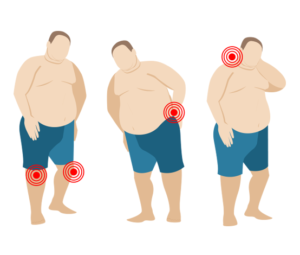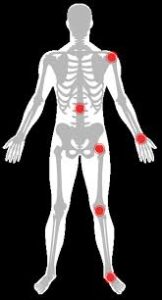Obesity has become a significant health concern worldwide, affecting millions of individuals of all ages. While medical research has widely recognized its association with heart disease and diabetes, one often overlooks the impact of obesity on joint health. Excess weight places an incredible strain on the musculoskeletal system, particularly the joints, which are critical for mobility and overall well-being. In this article, we will delve into how obesity affects joints and explore the broader health implications of carrying excess weight.
How Obesity Impacts Joints
Obesity exerts a substantial strain on the musculoskeletal system, and joints bear the brunt of this burden. Several ways illustrate how obesity affects joints:
-
Increased Load: Individuals with obesity carry excess weight, imposing heightened stress on joints, especially those in the lower body such as the knees, hips, and lower back. This additional load accelerates wear and tear.
-
Inflammation: Adipose tissue, metabolically active, releases inflammatory substances. Chronic low-grade inflammation, a hallmark of obesity, contributes to joint pain and stiffness.
-
Mechanical Stress: Obesity alters biomechanics, potentially causing abnormal joint loading and uneven force distribution. This misalignment and uneven distribution can result in joint misalignment and cartilage damage.
-
Cartilage Degradation: The protective cartilage that cushions the ends of bones in joints may deteriorate more rapidly in individuals with obesity, leading to conditions such as osteoarthritis.
-
Reduced Range of Motion: Obesity can limit joint mobility, making it more challenging to engage in physical activities. This restricted movement further exacerbates joint problems.
Recognizing that obesity’s impact on joints is not limited to adults is vital. Children and adolescents who are obese also face an increased risk of joint issues, which can affect their long-term health and mobility.

Impacts of Obesity on Health
Beyond its effect on joint health, obesity has far-reaching health consequences, including:
-
Cardiovascular Disease: Obesity stands as a significant risk factor for heart disease, encompassing conditions like hypertension, coronary artery disease, and stroke.
-
Type 2 Diabetes: Obesity significantly heightens the risk of developing type 2 diabetes, a condition that can lead to serious complications if not appropriately managed.
-
Respiratory Issues: Obesity may impair lung function, giving rise to conditions like sleep apnea and asthma.
-
Metabolic Syndrome: Obesity is often linked to metabolic syndrome, a collection of conditions heightening the risk of heart disease, stroke, and diabetes.
-
Psychological Effects: Obesity can contribute to depression, low self-esteem, and social isolation, affecting overall mental well-being.
How obesity casuses degenrative joint diseases?
Obesity plays a pivotal role in the development and progression of degenerative joint diseases, with osteoarthritis being one of the most prevalent. Here’s how obesity contributes to degenerative joint disease:
-
Increased Joint Loading: Excess weight mechanically stresses joints, particularly weight-bearing joints like the knees. This constant loading leads to cartilage breakdown and the development of osteoarthritis.
-
Inflammatory Factors: Adipose tissue produces inflammatory molecules, promoting joint inflammation and accelerating joint degeneration.
-
Altered Joint Mechanics: Obesity can alter movement patterns, potentially causing misalignment and abnormal joint loading—both risk factors for osteoarthritis.

In conclusion, obesity’s impact on joint health and overall well-being is profound and extensive. Beyond increasing the risk of joint-related conditions such as osteoarthritis, obesity contributes to numerous other health issues. Recognizing the importance of maintaining a healthy weight and adopting a lifestyle that includes regular physical activity and a balanced diet is essential for preserving joint health and reducing the risk of associated health problems.
Read how the right nutrition can support your bones here.t
